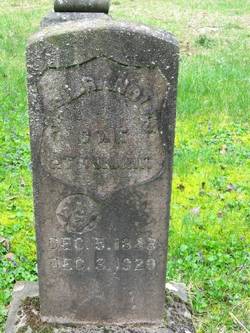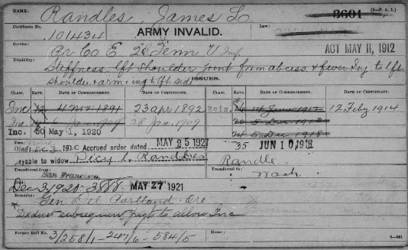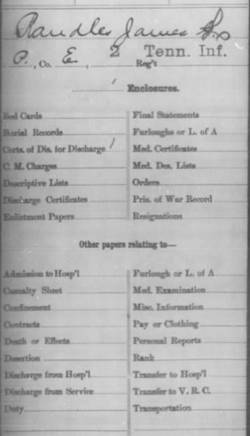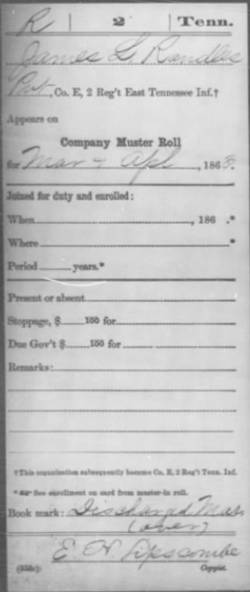James Lawson Randles
Representing: Union
Family History
James Lawson Randles
- Birth
- 5 Dec 1843
Sevier County, Tennessee, USA
- Death
- 3 Dec 1920 (aged 76)
Chehalis, Lewis County, Washington, USA
- Burial
- Centralia, Lewis County, Washington, USA
- Memorial ID
- 69209669
-
James Lawson Randles, age 77 passed away on Tuesday, December 3, 1920.
James will be laid to rest in Silver Creek Cemetery, Randle, Washington 98377.
James Randles was a Private in the Civil War, fighting on the side of the Union. He moved out west, deciding that the area surrounding Randle resembled the Appalachians where he grew up. He was the 3rd settler in the area. James hired a local native to bring mail back to Randle from Centralia, and decided to create a township in order that the federal government would pay for mail delivery. He drew up the petition and had other settlers of the area sign it. There was no city name on the petition, so the state (territory at the time) used the first name they saw on the petition. And thus, the city of Randle (minus the S from his surname) was named.
At the age of eighteen, James enlisted at Camp Calvert, Loudon, Kentucky, from Sevier County, Tennessee, on the 19th day of November, 1861, to serve three years or during the war. He was mustered into the United States service at Flat Lick, Kentucky, as a Private of Captain Andrew P. Sueter's Company E 2nd Regiment, Tennessee Volunteer Infantry under the command of Colonel James P. Carter. He was described as being six fee tall, of light complexion with blue eyes and light hair.
The regiment was recruited and organized at Camp Dick Robinson, Kentucky, and mustered into the US service to date from September 28, 1861. On October 18th of that year, the regiment marched to Wild Cat, Kentucky, to meet the rebel forces under Zollicoffer, and after the engagement it marched to Loudon, Kentucky, where it remained until December 5th, and then moving to Somerset. The Battle of Mill Springs took place, leaving few survivors.
On January 21, 186s, the regiment marched to Cumberland Ford, thence, march 7th to Big Creek Gap, where it roueted and captured a rebel cavalry force, destroyed a large amount of stores, captured 89 horses and mules, and a large amount of arms and ammunition. It returned to Cumberland Ford, remaining there until June of 1862, then moved again to Cumberland Gap, marching on september 17th to Saline Salt Works in the Kanwha Valley, West Virginia. Following this, the regiment moved to Point Pleasant, Ohio in November, moving from there by water to Louisville, Kentucky. The regiment marched to Murfreesboro, Tennessee and participate din the battle of stone River, December 31, 1862 - January 13, 1863.
The regiment remained in that state, participating in divers engagements until July 4, when it left Somerset in pursuit of the rebel General Morgan in his raid through Kentucky, Indiana and Ohio, and was present at Salineville when Morgan was Captured. It returned to Kentucky and joined the forces under General Burnside then organized at Stanford for the campaign of East Tennessee. It was int he advance at Wolf Creek and Loudon and present at Cumberland Gap when that place was surrendered by the rebels.
The regiment returned to Knoxville, and was in the advance of the column that moved into upper East Tennessee; brought on and participated in the Battle of Blue Springs, pursued the retreating enemy to Abington, Virginia, then returned to Rogersville Tennessee, where by a mistake of Colonel Garrard on the 7th Ohio Cavalry, it was captured on November 6, 1963 by the forces under rebel General Jones.
117 men, most of whom were on duty there during the siege, after which they marched to Clinton, Tennessee, skirmishing with General Wheller's forces for three days and nights on the way. Colonel Melton with the remnant of his regiment escorted General Burnside to Camp Nelson, Kentucky, then returned as Provost Guard at Sevierville, Marysville, Clinton and Maynardsville, Tennessee, until September 1864, when the garrison of 28 men were captured at marysville, and the remaining detachments were ordered to lee's Ferry, then retreated to Knoxville, where it remained until October 6, 1964, when it was mustered out, retaining only 106 of the original number.
James was sick in the hospital at Somerset, Kentucky, for several months and rejoined his regiment there after the battle of mill Springs, and remained with his company until after the Battle of Stone River, Tennessee. He rendered faithful and meritorious service while with his command and received an Honorable Discharge at nashville, Tennessee, on the 12th day of March 1863, by reason of Surgeon's Certificate of Disability.
Being the son of William W. Randles and Narcissa L. (Keener) Randles, James was born in Sevier County, Tennessee, on the 5th of December 1843. He was united in marriage to Dicy C. Erwin in Sevier County, Tennessee, September 13, 1965, from which union were born six children: Matthew, Flora, Charles and Stella amongst them. He was a member of GAR Post at Albany, oregon, and was a Past Commander of J.B.Matthews post #6 at Forest Grove, Oregon. He was a member of the A.F. & A.M. since 1866. He was Aide-de-Camp to Department Commander Sladen of Oregon.
James held public office as Coroner in Loudon County, Tennessee, Register of Deeds in Sevier County, Tennessee for four years, and Deputy County Court Clerk in Sevier County for four years. His wife's brother, James L. Erwin, served in the 3rd Tennessee Infantry in the Civil War.
Learn more at www.sticklinsfuneralchapel.com, and feel free to leave comments and stories as the Sticklin Funeral Chapel and the Randles/McMahan family prepares to bring James home to rest in peace with his family.
Source: https://www.dignitymemorial.com/obituaries/centralia-wa/james-randles-11238471
Lewis County family hopes to exhume, relocate remains of Civil War veteran
The founder of Randle is buried 50 miles away in Centralia.RANDLE, Wash. — Whitney McMahan hopes to pull off a family reunion for the ages.
Her great, great grandfather, James Randles, died in 1920 and was buried in Centralia’s Mountain View Cemetery. The rest of his family, generations worth, are buried in the town 50 miles to east that bears his name, Randle, Washington.
The Civil War veteran headed west and established the town of Randle in 1883. According to McMahan, the family wanted free mail delivery and the U.S. Post Office would only deliver to established cities or towns. That’s when the town took his name, sort of.
”He sent in the petition, and his name happened to be right on top, so they picked his name and dropped the S,” said McMahan.
Randles died in a hospital in the Centralia/Chehalis area December of 1920, and it was too difficult to have his remains moved the more than 50 miles on trails back to Randle, according to McMahan.
Ever since she discovered his gravesite more than 10 years ago, McMahan said she’s been working to have the grave exhumed and moved to Randle.
“It’s coming together. It’s going to happen,” said Wes McMahan, Whitney’s brother.
He said county officials told him the permits should be granted to have a re-burial in Randle this summer.
”Active military wants to give him an escort, the Veteran’s Administration wants to give him a color guard,” said Wes McMahan, ”Sort of a little bit of a historical mistake and yeah, we’re just happy and glad we might be able to correct it and bring him home!”
Source: https://www.king5.com/article/news/local/lewis-county-family-remains-civil-war-veteran/281-a5fb5022-5740-4ef9-ba48-3646b67e861a
Cemetery
Buried at Silvercreek Cemetery



